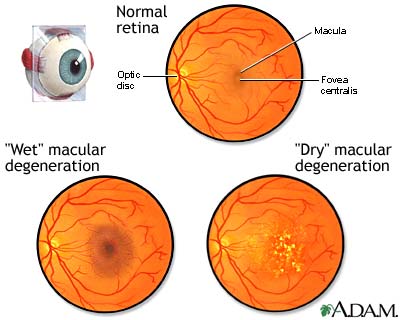Macular Degeneration
Lining the inner surface of the back of the eye is layers of vision fibers collectively known as the “retina”.
Description
Lining the inner surface of the back of the eye is layers of vision fibers collectively known as the “retina.” The central part of the retina is called the “macula,” which is responsible for our central vision. Unfortunately with macular degeneration these sensitive vision fibers deteriorate. Sometimes this can be mild with little noticeable symptoms. In other instances, macular degeneration can result in severe central vision loss, however, while macular degeneration can lead to permanent loss of central vision, it does not cause total blindness.
Some types of macular degeneration can develop abnormal blood vessel membranes that can hemorrhage, causing sudden loss of central vision. In some cases, a special laser therapy available at the Family Medical Eye Center can be used to treat these abnormal membranes and prevent further vision loss. Early detection, however, is the key to treating this disease and preserving your vision.

Symptoms
Blurred or decreased central close-up and distance vision, which is often delayed because patients subconsciously ignore the eye with worst vision prior to development of the condition in the previously good eye.
Blind spots or scotomas, are a direct result of lost macular function.
Straight lines look irregular or bent, called metamorphopsia, and objects appear a different color or shape in each of the eyes.
Objects appearing smaller in one eye than the other, called micropsia, may also indicate a swelling and bulging of the macula, leading to a greater distance between the individual photoreceptors, which in turn causes the brain to interpret the object as smaller than seen by the good eye.
Treatment
In general, people older than 45 years should have a complete eye examination and then follow-up examinations every one to two years.

